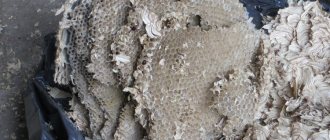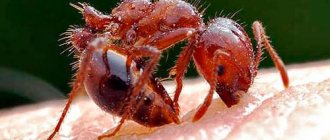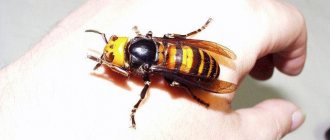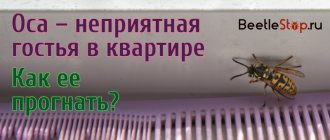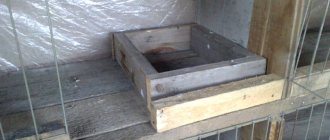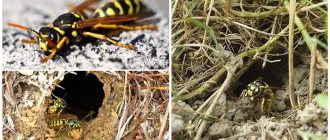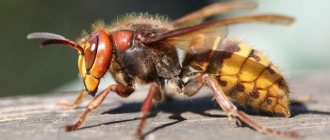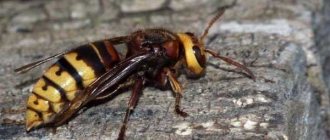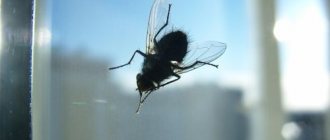Do you have an unglazed balcony or is it simply littered with everything “necessary”? Or did unscrupulous workers leave gaps in the seams? This means, sooner or later, you will have to ask yourself the question: “How to remove a wasp’s nest on the balcony?” In this article, we will try to reveal the secret of the appearance of wasps and methods of dealing with them.
A lone wasp itself is not a threat. One bite, although painful, will not lead to serious consequences (of course, if there is no allergy). But wasps defending their nest are extremely aggressive. Each individual will protect the uterus at the cost of its own life. Numerous bites can lead to serious intoxication of the body. Therefore, no matter how humane you are, the hive must be destroyed.
Where do wasps hide their home?
Autumn time has come, and you noticed a lonely wasp on the balcony. And calmly releasing her into the wild, they forgot in a few minutes. And in the spring, when they got ready to grow seedlings or just take a breath of air, they were forced to capitulate due to an encounter with a dozen insects. How did this happen?
It turns out that if a wasp flew to you in the fall, and even with the windows closed, there is reason to be wary and start looking for cracks immediately. That same lonely wasp returned to the warm balcony and spent the winter there safely. And in the spring, she began to arrange her home. If the female begins to build a nest, this is a serious problem for all family members. It's time to look for the hive.
Where should I start? The most popular settlements can be divided into 2 types: internal (ceilings, cracks in walls and cladding, stored items) and external (under a window sill or eaves, in storm pipes).
If the gray, cone-shaped, humming house does not immediately catch your eye, you can try to track it down. Set up an ambush on the balcony. If you see where wasps dive most often, you probably found a hive. But what if there are wasps, but they periodically fly in just to have a snack? This means it’s time to go outside and inspect the loggia from the outside.
When traditional methods are powerless
Chemicals should be used as a last resort, because not all of them are harmless to health
If you are afraid of setting fire to or drowning a wasp nest on your balcony, I can recommend resorting to insecticides. Fortunately, there are many such drugs in stores. I can highlight some of them:
- Karbofos;
- Get;
- Cucaracha;
- Tetrix;
- Executioner;
- Sinuzan.
Spray products are most convenient to use
I advise you to choose liquid water-soluble products, or those drugs that are sold in aerosol form. With them, the extermination process will be much more convenient.
To fight wasps. Basic methods of destruction
So, the hive has been found. But how to get rid of a wasp nest on the balcony without destroying the floor of the apartment. It’s worth mentioning right away that you won’t be able to simply get the wasps out of the house. This is the same as evicting residents of a multi-storey building a year after moving in. Insects will defend themselves and protect their queen, even at the cost of their lives. Therefore, you either need to block the entrance to the balcony, or get rid of the wasp’s nest using the methods presented below.
Method No. 1. Poison
The method is effective, but time-consuming. It will take about a week (maybe more). But you can get rid of other crawling/flying insects, if any, at once.
Necessary:
- prepare an unnecessary container (you can cut a plastic bottle) with holes;
- mix honey with boric acid and pour into the prepared trap;
- place the “treat” near the wasp’s nest (it’s safer to do this at night);
- check after a week for the presence of living individuals.
Regarding the last point, you should be careful. Firstly, do not rush to check the result. Secondly, the adults will carry the poison into the hive and spread the bait to the larvae, and then to the queen. This means that when checking, no one should buzz in the nest. This should be checked with a long stick by knocking on the socket. Carry out all actions against bees with the door open to allow escape. You will probably have to add more filling if the process is taking too long and there are still enough live wasps.
Method No. 2. Drowning
What if the balcony is constantly used and there is no time to wait for the results of etching? How to remove a wasp nest on a balcony in the summer in a few hours? Very simple and economical. True, there will be a caveat here - the method is only for a flat ceiling. And so, you will need to prepare: a bucket, water and a stepladder.
Now, fill a bucket suitable for the size of the nest with water to the brim. Carefully and without sudden movements we “put” it on the hive. We support it with a stepladder. All. To check the result, tap the bucket with a stick. If there is no buzzing in response, the balcony is cleared.
Method No. 3. Burning
Do not use on plastic and wooden balconies. You should resort to this method only if the question is “How to get rid of a wasp nest on the balcony?” - is very sharp. The hive will blaze like a torch, you may not be able to extinguish the fire on your own without consequences! But it is very convenient as a deliverer under the balcony. On a concrete base, for example, or on a brick wall. But still, you should be extremely careful and warn your neighbors.
Again, it is worth going out to fight wasps at night. At this time, insects are sleepy and inactive. Prepare a set of spray bottle and gasoline. Carefully spray the nest with flammable liquid. There is no need to fill the floor of the wall; the hive is highly flammable. And immediately set it on fire. Have a bucket of water or a fire extinguisher ready just in case.
Method No. 4. Chemicals
No matter what insects appear at home, most residents run to the store for supplies. Now there is a huge selection of insecticides (chemicals) on the shelves. Therefore, choosing the right one will not be difficult.
Methods of their use depend on the type of active substance. But, to achieve faster results, you will need an additional accessory. Plastic bag. Fill it with purchased poison and tape tightly around the nest. It is better to leave such a trap overnight. We check it in the standard way - tap the bag with any object, if there is no buzzing - everything was successful.
Method No. 5. Fumigation with smoke
The method is folk and quite ancient. Due to the strong smell and smoke, it is not recommended to use it in a city apartment. This product is more suitable for treating country houses. Also, the method is time consuming. To implement this you will need: a “potbelly stove” and fresh pine needles. If you still intend to carry out this procedure in the apartment, inform your neighbors. Otherwise, the arrival of emergency services cannot be avoided.
So, place a “potbelly stove” under the hive, melt it with fresh pine needles (possibly with the addition of plastic), point it at the nest, and heat it until the wasps give up the territory.
Method No. 6. Polyurethane foam
If you have sufficient skill in handling this building material, then this option is just for you. Like the previous methods, it should be performed closer to night.
So, prepare a balloon, try to approach the nest as quietly as possible, and then blow out the entrance. The method is extremely inhumane, but if there is a choice - the safety of the family or the life of insects, you have to choose. All that remains is to remove the nest and carefully carry it away. The place where the hive was located must be thoroughly treated with a strong-smelling disinfectant and washed with potassium permanganate. This is done to prevent settlers from returning to their favorite territory.
Method No. 7. Kerosene
Again, the traditional way. A relatively humane method, because adults will still leave their nest alive. The only thing left to do is throw the house away. To do this, you will need to coat the nest with kerosene every night. Continue until there are no adults left.
Method No. 8. Extreme
It should only be used as a last resort. Suitable only for low-lying nests. You should be especially careful when handling boiling water.
And so, you need to prepare a pan of suitable volume and fill it with boiling water. Then put it tightly on the socket. Support it with a stepladder as in the case of ordinary water. This cruel method will get rid of wasps in a very short period.
There are quite a lot of methods of struggle, some are quite extreme and it is better not to make them public. From the methods collected in this article, everyone can find one that suits them. The key to any approach is to be vigilant and cautious.
What do all wasp nests have in common?
All wasps make their nests from the same material and using the same technology: they gnaw the soft young bark on tree branches, chew it, moisten it with their saliva and ferment it, and thus turn it into a substance similar to wet paper. They stick pieces of this substance to an existing structure, and after drying they stick together very securely.
In a similar way, the nest is attached to the ceiling or branch - a piece of “paper” is simply attached, dries, hardens, another is attached to it, and a base is formed. Sometimes it looks like a leg:
Sometimes the top of the nest is entirely attached to the base, or, if it is a branch, covers it.
By the way, due to the fact that the nest material resembles paper, all wasps that use it are classified as “paper” wasps. This is what we usually call the most common German wasps, but in fact this group includes all hornets and a large number of other species.
On a note
Due to the need for a large amount of building material for a massive nest, hornets sometimes gnaw off the bark of young trees so much that the trees die or do not grow green mass in a year.
As a result, due to the common building material and the general construction plan, the nests of all paper wasps have the following general characteristics:
- They are all light gray, sometimes with a slight yellowish tint, sometimes without it.
- They are all quite light. Even large hornet structures weigh only a few hundred grams (on average less than 100 grams). Therefore, by the way, they can hang on ceilings and branches.
- The larger the nest, the less open honeycomb remains in it, not protected by the outer walls of the honeycomb. Nests the size of soccer balls almost always have only one entrance.
- The horizontal sections of all nests tend to be round in shape, that is, the nests themselves are most often either spherical or spindle-shaped. But, as we saw above, this rule is often violated.
Finally, another interesting property: the same nest is almost never reused by wasps the next year. Perhaps in the spring, when looking for a place to found a nest, the founding female instinctively avoids old nests, which may contain numerous parasites that terrorized the previous family and are awaiting the appearance of new settlers. Even if the wasp really likes a place with a nest already hanging, she begins to build a new one nearby, sometimes using the old one as a support or wall, but never founding a family in a house that was not built by her or her children.
However, such general features of nests do not allow in many cases to easily and quickly find a nest placed in a ready-made crevice or niche. But experts can sometimes determine the type of its owners by the appearance of the nest, without seeing the wasps themselves.
Chemical means for destruction
On the shelves of a hardware store there is a huge selection of insect repellents. And you don’t have to look for a spray can with a wasp icon among them. A remedy against any insects, even garden ones, is suitable as a poison. After all, their biochemistry is based on similar functions. Therefore, you should not look for a miracle drug and overpay huge sums for it. You just need to figure out what types of insecticides there are, what the differences are and what is important to pay attention to.
The wasp nest, in most cases, is located vertically, so it is more convenient to consider the option in the form of an aerosol or a concentrate diluted with water. So, in the future, simplify your task with the help of a spray bottle. But powder cannot destroy the hive. But it can be used as a replacement for boric acid in bait.
The selected product must meet basic requirements. Firstly, it does not have a strong odor and has low toxicity, i.e. not pose a danger to both people and domestic animals. Secondly, be highly toxic to insects and have a good rate of exposure. It is worth keeping in mind that exterminating adults is not enough. It is necessary to destroy both the larvae and the queen in the nest.
Types of insecticides:
- Concentrates
. A universal option. They combine cost-effectiveness and high efficiency. If diluted with water according to the instructions, they can be used to treat the hive. In undiluted form - as an additive to bait. These include: Karbofos, GET, Lambda-zone, Delta-zone, etc. - Ready-made aerosols
. A more expensive option, but immediately ready for use. For example: Clean House, Bros, Delecia, Mosquitall, etc. - Powders and gels
. Ideal for making traps. These include: borax or boric acid, etc. - Glue
. More useful for catching individual adults.
In general, chemical products are presented in a wide range. Everyone has their own positive and negative qualities. And all that remains is to make a choice based on your own preferences.
Which nests are the most difficult to destroy?
And finally, the most interesting thing: is there a difference in the destruction of different types of wasp nests? Are there nests that can be removed in five to ten minutes, and how are they different from those that take hours to deal with?
Our practice shows that the difficulty of destroying a wasp nest depends not so much on its shape, age and size, but on its location.
For example, the easiest way to remove nests is:
- Hanging at human height (maximum reachable from a stepladder) on an open ceiling or branch.
- Equipped in closed or semi-enclosed spaces (sometimes you can manage to pack them in a bag before the wasps fly out).
- Located in earthen burrows (it’s enough just to pour insecticide in here until the wasps stop getting out).
But if we talk about appearance, the easiest to destroy are the classic round nests and nests in the very early stages of construction. Even a person without special equipment can handle a nest of 5-10 cells, which is served by a queen and her two or three daughters. If there are more wasps, then trying to remove the nest can already pose a danger.
On the contrary, the most difficult nests to eliminate are:
- Nests located inside building structures. They are difficult to treat with insecticide and remove. Moreover, sometimes it is completely impossible to remove such a nest without disassembling the structure itself.
- Nests located deep in dense thickets of bushes. For example, on one trip such a nest was located inside a hedge, and somehow it was almost impossible to manipulate the sprayer near it.
- Nests hanging high on poles or trees. There are situations when a wasp “pear” hangs 8-9 meters above the ground on a power line insulator. It is extremely difficult to get to it - ordinary ladders do not extend to such a height - and working here is dangerous due to the proximity of wires. And on some poplars at a height of 13-14 meters above the ground, such a nest is practically unattainable.
We have had cases when we had to remove part of a slate roof, tear off insulation sheets from the facade, and work on the outside of the walls of high-rise buildings. It happened that I had to call the guys from the tree trimming service, who have the equipment and experience to climb a tree to the height of the seventh floor and work here. Once, in order to destroy a nest, I had to call the RES and turn off the electricity to the entire gardening community. And several times already the wasps had to be destroyed together with firefighters.
That is, situations can be both simple and very complex. Therefore, there is no universal recipe for destroying wasp nests - you need to look at each nest, choose a method for its elimination and take into account all the circumstances. But in any case, it is possible to destroy a wasp’s nest. Just call us, we will come, assess the situation and make sure that the wasps will no longer bother you.
Security measures
How to remove a wasp nest on the balcony without getting hurt? Well, first you need to realize that a wasp guarding a hive is extremely dangerous. Even more dangerous is the attack of a whole swarm of wasps. Therefore, it is better to warn yourself and fulfill a number of important conditions:
- choose suitable clothing (closed shoes, gloves, a beekeeper’s mask is ideal);
- carry out all the machinations at night, when the wasps are inactive;
- act quickly and thoughtfully.
If the swarm becomes aggressive, immediately return to the apartment. Like any other living beings, after some time they will calm down, and the sabotage can be repeated.
Should I touch a wasp's nest on the balcony?
Why do doctors strongly advise removing a wasp's nest from the balcony? Perhaps humans can coexist peacefully with insects of this species?
The danger is that wasps perceive any intrusion into their territory as obvious aggression. The housewife goes out to hang up the laundry, moves her hands, takes out clothespins, shakes off the pillowcases - stinging insects perceive all actions as a threat. The answer is immediate: a sting, an attack on a person to protect its nest and young individuals. Representatives of the stinging species do not understand who came out onto the balcony: a child or an adult, which makes an encounter with wasps even more dangerous.
Other important negative factors:
- wasps do not leave a sting and can attack several times, which increases the danger from bites;
- Also, stinging insects often carry certain diseases.
Prevention is the best solution
Dealing with a problem such as wasps on the balcony is an extremely difficult and lengthy procedure. And it is better to prevent this struggle, or eradicate it at the initial stage.
How to minimize the risk of wasps settling on your balcony:
- the balcony should be glazed, ideally;
- the seams between the sheathing and the wall are carefully sealed;
- It would not hurt to protect the storm pipe with a grate;
- do not leave open jars of jam or honey;
- do not turn the balcony into a warehouse, or periodically arrange an audit.
By following these rules, you can free yourself from unnecessary problems. No one wants to destroy an entire population of wasps. In nature, they have their value, so let's be vigilant and not lead to the need for a fight.
In conclusion, it is worth summarizing the main points:
- there is no need to destroy one accidentally lost wasp; it is enough to help it get out into the wild with the help of a matchbox or glass jar;
- If you do find a hive, do not try to knock it down with a stick, as you may provoke wasps and get seriously injured;
- do not risk using extreme folk remedies;
- when choosing chemicals, pay special attention to the safety of the product (it is more convenient to use ready-made aerosols and concentrates);
- follow preventive measures - regularly, in the spring, check the balcony for the presence of wasps, so you will not miss the start of construction of the hive.
Follow simple rules and the question of how to get rid of a wasp nest on the balcony will bypass you.
Professional pest control
The desire to get rid of dangerous insects on the balcony on your own often leads to the development of severe allergic reactions due to numerous bites. A special service will effectively deal with wasps and hornets. Advantages of turning to professionals:
- the ability to quickly and relatively inexpensively get rid of pests and prevent their subsequent appearance;
- qualified employees work quickly, efficiently, use proven means and specific tactics for exterminating wasps and hornets;
- receiving recommendations;
- there is no need to purchase chemicals, protective clothing, equipment, and then store them;
- there is no risk of bites or injuries.
Where should Muscovites and residents of the Moscow region apply for premises disinfestation services:
| Name | Telephone | Disinsection methods | Cost of services, rub. |
| MosEcoDez | +7 |
|
|
| Unified Sanitary Service of Moscow (ESS, SES) | +7 |
|
|
| Dez Eco-Clean | +7 +7 |
|
|

